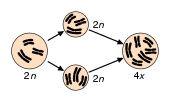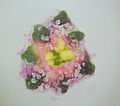Quinoa
![]()
This article describes the plant species quinoa. For the company of the same name, see Quinoa (education).
Quinoa (pronounced kiˈnoːa, originally from Quechua: kinwa, pronunciation: ˈkinwɑ) (Chenopodium quinoa), also known as rice quinoa, is a plant species of the goosefoot genus in the foxtail family (Amaranthaceae). It has been known as a cultivated plant in the Andes for about 5000 years. The plants are undemanding and thrive up to altitudes of 4200 m. The closely related and similarly used Chenopodium pallidicaule (Cañihua) is cultivated up to 4550 m altitude.
The small, on average approx. 1-2 mm large and approx. 1-5 mg heavy single-seeded nutlets of these plants are an important staple food of the mountain peoples in these high regions, as maize can no longer be cultivated at these altitudes. The thousand-grain weight is approx. 1-5 g.
UN Secretary-General Ban Ki-moon declared 2013 the Year of Quinoa. Due to its specific advantages, the plant should help to fight hunger in the world, especially in times of climate change.
Description
Quinoa is an annual, mostly gynomonoecious (which means: there are hermaphrodite flowers as well as purely female flowers), herbaceous plant with a growth height of 50-300 cm. It forms richly branched taproots, usually about 30-50 cm long, but these can reach up to 1.5 m deep. The erect stem, initially solid and soft inside but later hollow and spongy, compact and firm outside, cylindrical below, then ribbed, is green, yellow, purple or dark red in colour, or striped, up to 5 cm in diameter. It is usually branched, but occasionally unbranched.
The leaves are four-sided alternate, with a petiole fluted on the upper side, simple, thickish, up to 15 cm long and up to 8 cm wide, initially green, later yellow, purple or red. The polymorphic leaves are trowel-shaped (trullate) in the lower part of the plant, three-veined, rarely entire, usually cove-toothed, in the upper part narrowly elliptic to lanceolate, pinnately veined, entire or also cove-toothed, with shorter petioles. The leaves appear with a flat or wavy surface and are without stipules. The young leaves are often finely hairy on the underside.
The terminal, erect, yellow, red, but also pink-orange and violet inflorescences appear in various forms, they can be 15-70 cm long and are about 5-30 cm in diameter, they consist of knobbly partial inflorescences, each 1-5 cm long.
The flowers, appearing in clusters, are inconspicuous, female (2-5 mm) or hermaphrodite (3 mm), in hybrids sterile males may also occur, they are stalkless and five-parted, without petals. The five tepals are boat-shaped, keeled on the outside and more or less acute. The hermaphrodite flowers have five stamens and 2-3 feathery stigmas, and an ovary, the female ones are without stamens. The superior ovary develops after self- or cross-fertilization into a lenticular (lenticular), elliptoid, round to sharp-edged, about 1-4 mm, hard, yellow, orange, red, pink, white, cream, brown, gray, or black (pericarp), dicotyledonous, multilayered achene. The embryo is curvilinear (campylotropic) and surrounds the starchy perisperm median.
It is frost and drought resistant and grows on permeable, nitrogen and calcium rich soils, with a pH of 4.5 to 9, preferably sandy to sandy-loamy soils, it accepts well different climates, the temperature range is -8 °C to +38 °C, ideal is 15-20 °C. Depending on the genotype, quinoa is a long day plant (LTP) or short day plant (KTP), as well as neutral.
Quinoa is a facultative, C3, recreto-endo halophyte that excretes excess salt via epidermal blister cells (EBCs) (papilla). Parts of the plant are often covered with these vesicular, colourless, translucent or purple pigmented excretions, often on young leaves.
Genetics
Quinoa is allotetraploid with a chromosome number of 2n = 4x = 36. As an allotetraploid, it is derived from the hybridization of two diploid parental species whose genomes are designated A and B, respectively. Source of the A genome is Chenopodium pallidicaule Aellen (called Cañahua, or Kañiwa), an annual species of the Andes that is also cultivated. The source of the B genome is the Swedish goosefoot Chenopodium suecicum Murr. In quinoa, the entire genome has probably been completely duplicated once again compared to the combined genome of the parent species. In addition, there has been extensive rearrangement of the entire genome with large-scale exchange of homologous sections of the two parent species between different chromosomes. The formation of the (now hypothetically inferred) allotetraploid parent clan was followed by a number of wild-growing, spontaneously feral or cultivated clans, most notably the Berlandier's goosefoot Chenopodium berlandieri Moq. and the Bock's goosefoot Chenopodium hircinum Schrad. According to genetic data, the Bocks goosefoot is the most closely related. Since different genetic lineages of quinoa and buck goosefoot are non-monophyletic against each other, it is possible that the lowland and upland forms of quinoa would have arisen independently from ancestors from this species. This suggests a twice independent domestication of quinoa, once in coastal Chile and once in the Altiplano.
Most quinoa cultivars, landraces and clans are genetically relatively uniform, which is attributed to predominant self-pollination.
·
Quinoa plants at 3800 m above sea level in Apurímac, Peru
· 
Comparison of quinoa (left) and common wheat (right)
· 
Quinoa "red faro", fruits and seeds
· 
quinoa seeds, you can see all around in the middle the crooked (kampylotropic) cotyledon plant
·
Colored Quinoa Seeds
·
Half-opened quinoa flower with salt exudates, in the middle the large yellow anthers and two small feathery stigmas are visible
·
Salt bubbles on a quinoa leaf

Graphical representation of the ontogeny of the quinoa genome: duplication of a diploid genome (2n) leads to tetraploidy (4x).
Search within the encyclopedia



